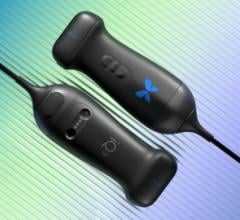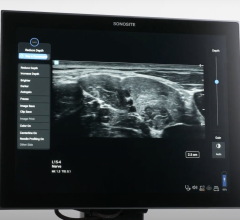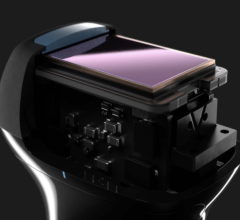For a 2016 update to this article, read the article and related links at "Advances in Ultrasound."
The overarching trend in ultrasound continues to be the development of smaller and more powerful imaging platforms. The provision of hand-carried systems that offer advanced functionality and premium image quality in a small, easy-to-use and affordable package has almost become essential to growth in ultrasound over the last few years.
Two recently released products that exemplify the state-of-the-art in hand-carried ultrasound are Sonosite’s Nanomaxx and GE Healthcare’s Venue 40 systems. Each weighing only 6 pounds, both of these systems are tablet-style devices that provide simple user-interfaces and can be mounted on a cart. Despite their compact form, these systems offer capabilities such as color power Doppler and come equipped with many of the latest image-enhancing technologies, including speckle reduction, auto image optimization algorithms and color flow mapping.
With launches of three more pocket-sized ultrasound systems since the Siemens Acuson P10 in late 2007, the concept of handheld ultrasound has gained increasing attention. Released in early 2010, the GE Vscan is similar to the Acuson P10 in that it features a phased array transducer and operates in the 2-4 MHz frequency range. But, a significant improvement is that in addition to providing fundamental and harmonic black/white imaging, Vscan also offers color Doppler imaging.
Pocket ultrasound devices have also shrunk considerably, with the lightest, the Signostics’ Signos, weighing only 0.7 pounds. While the Signos does not provide color Doppler, a unique advantage of this system is its ability to be used with a higher frequency transducer for superficial imaging.
The most recently introduced pocket ultrasound from MobiSante, the MobiUS SP1, is composed of an ultrasound probe, software and a smartphone that enables image transfer via WiFi networks.
Other Developments
Despite overshadowing by the ongoing trend in hardware miniaturization, there also have been several noteworthy developments of new software-based technologies. They address previous shortcomings of ultrasound, simplify integration with other diagnostic image data and bring improvements to clinical workflow.
Released in 2010, Advanced Needle Visualization is Sonosite’s proprietary software algorithm for improved needle visualization during ultrasound-guided interventional procedures, such as biopsies, nerve blocks and vascular access. Poor visualization of needles inserted at steep angles and toward deep targets has been a limitation of ultrasound. This phenomenon is caused by a reduction in echoes from the needle shaft and tip when a needle is tilted at angles of more than 15-20 degrees. This software allows clear visualization of needles at angles of more than 50 degrees and is expected to have a considerable impact on the speed and success of these procedures.
Other software advancements include the ability to co-register and fuse real-time ultrasound with images acquired using other modalities, such as computed tomography (CT), magnetic resonance imaging (MRI) and positron emission tomography (PET). This capability was introduced by GE Healthcare in late 2008. Several vendors also have introduced software that automate tasks and anatomical measurements.
One noteworthy example is Toshiba’s recently launched Auto-IMT (intima-media thickness) technology, which has helped make risk assessment for cardiovascular disease faster and easier.
Elastography software has existed since the late 1990s, but has only recently started becoming more quantitative in nature. Though not yet commercially available in the United States, Siemens Virtual Touch tissue quantification application, part of its acoustic radiation force impulse (ARFI) technology, enables quantitative measurements of tissue stiffness that are intended to lead to more objective diagnoses of pathologies in the breast and organs such as the liver. Quantitative elastography is expected to improve clinical decision-making and lead to fewer unnecessary invasive procedures.
Zonare’s Zone Sonography Technology (ZST) replaces the image processing and scan converting components of conventional systems. It uses a software-based solution to reduce cost and size, enables easier upgradeability and significant improvements in image quality and acquisition speed. This is achieved through a novel technique that acquires larger volumes of data from a smaller number of “zones,” rather than the line-by-line acquisition used by most systems.
Transducer Improvements
There have been significant advancements in transducer technology, particularly with the development of Philips Healthcare’s PureWave crystal technology. Using a new manufacturing process, Philips was able to produce a transducer crystal with fewer defects and more uniformity than the crystals used in conventional piezoelectric-based ceramic transducers for more than 40 years. These new crystals not only yield considerable improvements in the precision and efficiency of energy conversion, but also made it possible to provide operation over a broad range of frequencies that previously required use of more than one probe. Philips’ PureWave crystals are complemented by the manufacturers’ xMatrix array technology, which enables simultaneous acquisition of two orthogonal imaging planes, allowing 2-D and 3-D imaging to be performed using a single imaging probe.
Frost & Sullivan enables clients to accelerate growth and achieve best-in-class positions in growth, innovation and leadership. It leverages 50 years of experience in partnering with Global 1000 companies. For more information: www.frost.com


 April 08, 2024
April 08, 2024 








